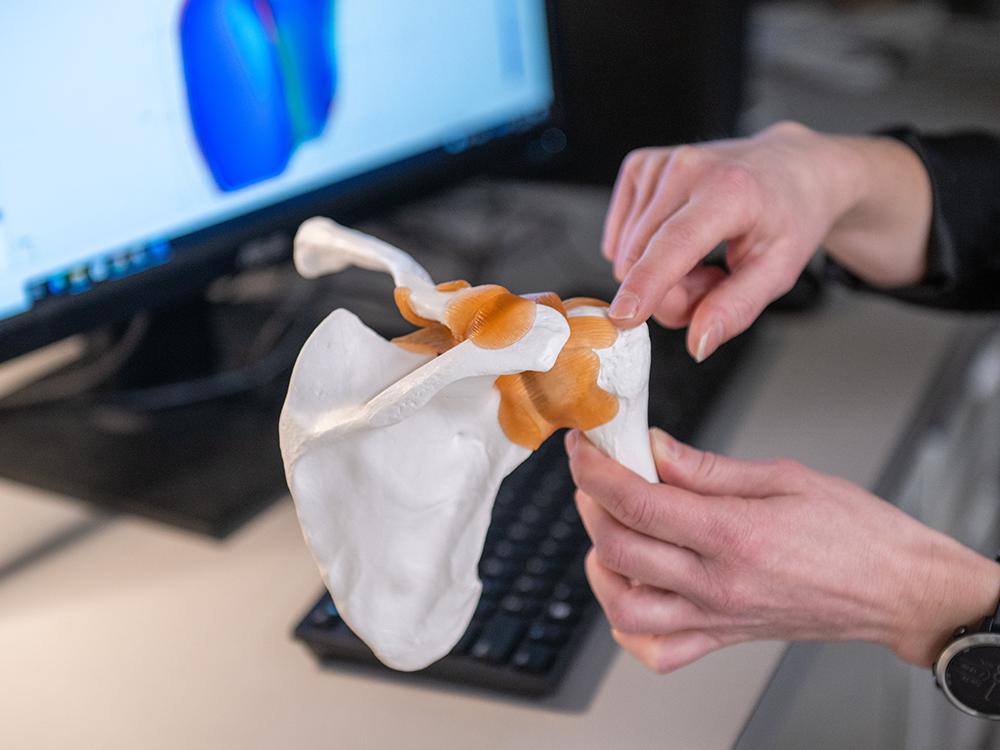College of Medicine researcher awarded $2.3M grant to enhance understanding of rotator cuff injury

Rotator cuff injuries are the second leading cause of musculoskeletal pain, following lower back pain. Their prevalence increases with age, with individuals over 80 years old at a 64% risk of the injury. While therapy and surgery can help with recovery, the initial injury rarely heals completely and can often induce secondary injury to adjacent muscles and impact function.
Now, with a five-year, $2.3 million Stephen I. Katz Early Stage Investigator Research Project Grant from the National Institutes of Health’s National Institute of Arthritis and Musculoskeletal and Skin Diseases, researchers from Penn State and the University of Oregon are collaborating to better understand how both injury and surgical repair affect the muscle’s composition.
“Our goal is to understand what’s actually happening to muscle composition and structure after a rotator cuff tear — after all, statistics indicate that at least half of us will probably have a cuff tear at some point in our lives,” said Meghan Vidt, PhD, lead principal investigator and assistant professor of biomedical engineering and of physical medicine and rehabilitation. “We’re looking at how strength and function change, especially as fat infiltrates the muscle, over time. There are a lot of studies that touch on this, but what makes this study unique is that we are looking at these changes comprehensively.”
Fat moves into the muscle as it atrophies after injury, meaning that it simply does not function as well as it did pre-injury, Vidt said. Using animal models, the researchers will use magnetic resonance imaging (MRI) and multi-scale mechanical testing to analyze how the muscle changes structurally and functionally during this process.
“We want to interrogate how the composition and the architecture of the muscle fibers change,” Vidt said. “Function follows structure. If the structure of the muscle changes, the function may change. We have to understand these associations to improve outcomes for patients.”

Meghan Vidt’s team includes three doctoral students pursuing degrees in biomedical engineering. From left to right: Joshua Pataky, Lilla Caton, Vidt and Zoe Moore.
Once the team has the experimental data, they also plan to develop a computational model to perform simulations and better understand the structure-function associations of muscle. They also plan to put this model in the hands of clinicians who can adjust parameters in the model and predict the outcome for a human patient.
“Current surgical repair success rates are quite variable, and most patients never completely get back to pre-injury status,” Vidt said. “If we can understand the mechanisms driving the system and those impacts, and scale up to assess strength, mobility, and function, that gives us the opportunity to help clinicians identify and target with treatment the biggest factor influencing function. We want to get this model into the hands of a surgeon, who can match the patient presentation and adjust variables — based on our experimental understanding — to predict patient outcomes and direct treatment plans.”
Vidt’s co-collaborators include Thomas Neuberger, associate research professor in the Penn State Huck Institutes of Life Sciences and director of the High Field Magnetic Resonance Imaging Facility, Materials Research Institute; April Armstrong, MD, vice president of orthopaedic services for Penn State Health Medical Group, C. McCollister Evarts Distinguished Professor and Chair, chief of surgery for the Division of Shoulder and Elbow in the Department of Orthopaedics and Rehabilitation in the Penn State Health Milton S. Hershey Medical Center; Timothy Mosher, MD, Kenneth L. Miller Chair and Distinguished Professor of Radiology and distinguished professor of orthopaedics and rehabilitation and of pediatrics; and Damien Callahan, assistant professor of human physiology, University of Oregon.
“We’re working to answer some of the questions I’ve had burning for many years, which required a shift in my research direction,” Vidt said, who previously focused primarily on shoulder function under various conditions rather than structure. “That shift led me to this really talented collaborative team of investigators, which includes Dr. Callahan, who has experience mechanically testing single muscle fibers. We’re learning new techniques and bringing that niche expertise to Penn State, where it does not currently exist.”
Vidt also said that graduate students will participate on the project, with the goal of gaining hands-on experience of learning and teaching new skills, as well as learning more about collaborations across fundamental and translational research to clinical application.
“The prize we’re eyeing is the clinical translation,” Vidt said. “Once we understand how muscles change in this context, we will be able to explore muscle morphology and function in other clinical populations, such as low back pain. Our model could help inform progression and timeline in clinical assessments to better tailor treatments and improve patient outcomes.”
The researchers will collaborate with veterinary staff and follow best practices for animal care, as established by Penn State’s Institutional Animal Care and Use Committee.
If you're having trouble accessing this content, or would like it in another format, please email Penn State Health Marketing & Communications.
